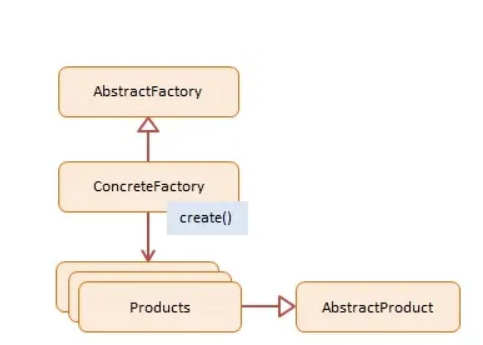- 联系我们
- duidaima.com 版权声明
- 闽ICP备2020021581号
-
 闽公网安备 35020302035485号
闽公网安备 35020302035485号
 闽公网安备 35020302035485号
闽公网安备 35020302035485号
设计模式是针对常见软件问题的高级面向对象解决方案。模式是关于对象的可重用设计和交互。在讨论复杂的设计解决方案时,每个模式都有一个名称并成为词汇表的一部分。本文主要介绍几种常见的设计模式。大多数情况下,它们遵循原始图案设计的结构和意图。这些示例演示了每种模式背后的原则,但并未针对 JavaScript 进行优化。

//堆代码 duidaima.com
function Employee(name) {
this.name = name;
this.say = function () {
console.log("I am employee " + name);
};
}
function EmployeeFactory() {
this.create = function (name) {
return new Employee(name);
};
}
function Vendor(name) {
this.name = name;
this.say = function () {
console.log("I am vendor " + name);
};
}
function VendorFactory() {
this.create = function (name) {
return new Vendor(name);
};
}
function run() {
var persons = [];
var employeeFactory = new EmployeeFactory();
var vendorFactory = new VendorFactory();
persons.push(employeeFactory.create("Joan DiSilva"));
persons.push(employeeFactory.create("Tim O'Neill"));
persons.push(vendorFactory.create("Gerald Watson"));
persons.push(vendorFactory.create("Nicole McNight"));
for (var i = 0, len = persons.length; i < len; i++) {
persons[i].say();
}
}
02.Builder (建造者模式)
function Shop() {
this.construct = function (builder) {
builder.step1();
builder.step2();
return builder.get();
}
}
function CarBuilder() {
this.car = null;
this.step1 = function () {
this.car = new Car();
};
this.step2 = function () {
this.car.addParts();
};
this.get = function () {
return this.car;
};
}
function TruckBuilder() {
this.truck = null;
this.step1 = function () {
this.truck = new Truck();
};
this.step2 = function () {
this.truck.addParts();
};
this.get = function () {
return this.truck;
};
}
function Car() {
this.doors = 0;
this.addParts = function () {
this.doors = 4;
};
this.say = function () {
console.log("I am a " + this.doors + "-door car");
};
}
function Truck() {
this.doors = 0;
this.addParts = function () {
this.doors = 2;
};
this.say = function () {
console.log("I am a " + this.doors + "-door truck");
};
}
function run() {
var shop = new Shop();
var carBuilder = new CarBuilder();
var truckBuilder = new TruckBuilder();
var car = shop.construct(carBuilder);
var truck = shop.construct(truckBuilder);
car.say();
truck.say();
}
03、Factory Method (工厂方法)
var Factory = function () {
this.createEmployee = function (type) {
var employee;
if (type === "fulltime") {
employee = new FullTime();
} else if (type === "parttime") {
employee = new PartTime();
} else if (type === "temporary") {
employee = new Temporary();
} else if (type === "contractor") {
employee = new Contractor();
}
employee.type = type;
employee.say = function () {
console.log(this.type + ": rate " + this.hourly + "/hour");
}
return employee;
}
}
var FullTime = function () {
this.hourly = "$12";
};
var PartTime = function () {
this.hourly = "$11";
};
var Temporary = function () {
this.hourly = "$10";
};
var Contractor = function () {
this.hourly = "$15";
};
function run() {
var employees = [];
var factory = new Factory();
employees.push(factory.createEmployee("fulltime"));
employees.push(factory.createEmployee("parttime"));
employees.push(factory.createEmployee("temporary"));
employees.push(factory.createEmployee("contractor"));
for (var i = 0, len = employees.length; i < len; i++) {
employees[i].say();
}
}
04、Adapter(适配器模式)
// old interface
function Shipping() {
this.request = function (zipStart, zipEnd, weight) {
// ...
return "$49.75";
}
}
// new interface
function AdvancedShipping() {
this.login = function (credentials) { /* ... */ };
this.setStart = function (start) { /* ... */ };
this.setDestination = function (destination) { /* ... */ };
this.calculate = function (weight) { return "$39.50"; };
}
// adapter interface
function ShippingAdapter(credentials) {
var shipping = new AdvancedShipping();
shipping.login(credentials);
return {
request: function (zipStart, zipEnd, weight) {
shipping.setStart(zipStart);
shipping.setDestination(zipEnd);
return shipping.calculate(weight);
}
};
}
function run() {
var shipping = new Shipping();
var credentials = { token: "30a8-6ee1" };
var adapter = new ShippingAdapter(credentials);
// original shipping object and interface
var cost = shipping.request("78701", "10010", "2 lbs");
console.log("Old cost: " + cost);
// new shipping object with adapted interface
cost = adapter.request("78701", "10010", "2 lbs");
console.log("New cost: " + cost);
}